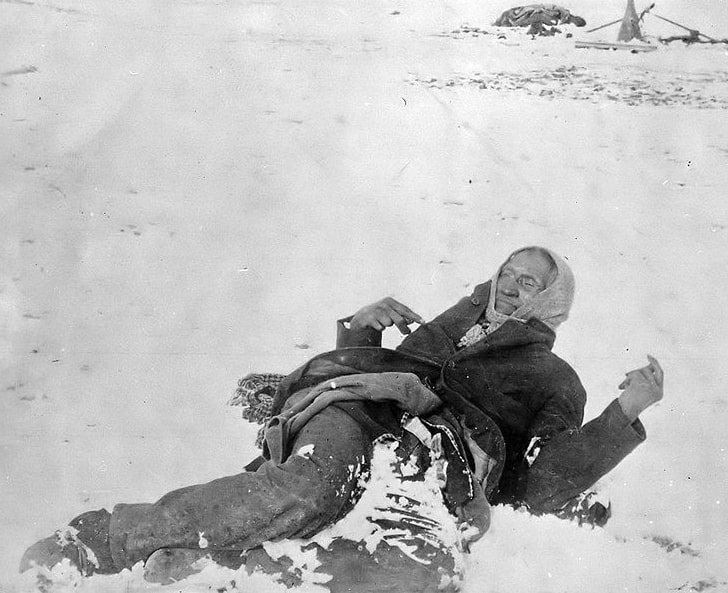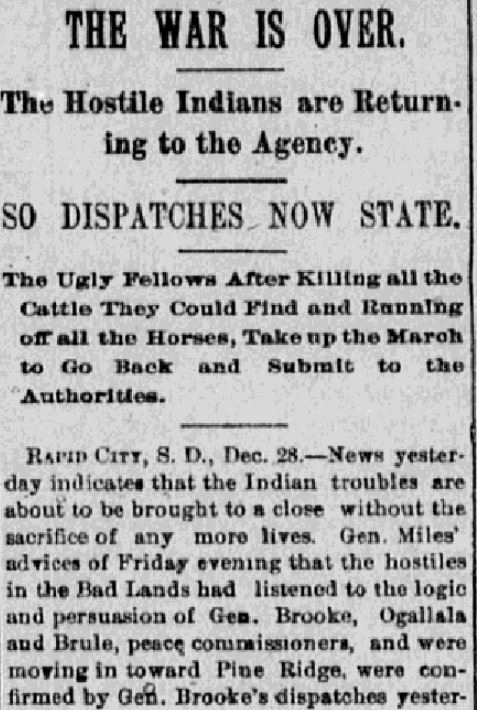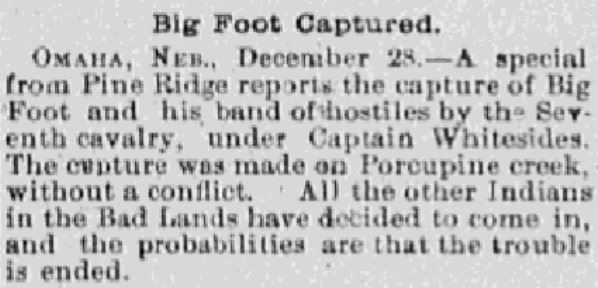December 1890 was a cruel month for the Lakota Indians. On December 15 Sitting Bull, a chief and holy man of the Hunkpapa Lakota, was killed along with seven of his followers by Indian police sent by a white man, Indian Service agent James McLaughlin, to arrest him. Just two weeks later Sitting Bull’s half-brother Spotted Elk (Big Foot) and his band of Miniconjou and Hunkpapa Lakota were slaughtered at the infamous Wounded Knee massacre on December 29.

Spotted Elk and his band surrendered on December 28, and were escorted by the U.S. 7th Cavalry – Custer’s old unit – to a campsite along Wounded Knee Creek in South Dakota. Of the 350 to 400 Indians in Spotted Elk’s band, all but 120 were women and children. They were surrounded by as many as 500 soldiers and four Hotchkiss guns (light artillery).
On the morning of 29 December 1890, the soldiers began disarming the Lakota men. A deaf warrior, Black Coyote, did not understand what was going on and refused to let the soldiers take his gun. In the struggle, Black Coyote’s gun went off, and suddenly bullets and artillery shells were flying everywhere.

Most of the Indian warriors were gunned down at the outset, then the soldiers chased the fleeing women and children, in some cases for miles, killing all they could find. A blizzard descended onto the scene of the massacre, and the wounded Indians were left to die in the cold. In all, as many as 300 Lakota perished in the massacre, the soldiers suffering 25 fatalities – many probably from “friendly fire,” i.e., other soldiers’ wild shots.
Twenty Medals of Honor were given to troopers for their role in the Wounded Knee “battle,” the most awarded for any single engagement in the history of the U.S. Army.
On the day of the massacre, the Knoxville Journal published an article predicting “the Indian troubles are about to be brought to a close without the sacrifice of any more lives.” Sadly, they were all too wrong.

Here is a transcription of this article:
THE WAR IS OVER.
The Hostile Indians Are Returning to the Agency.
So Dispatches Now State.
The Ugly Fellows after Killing All the Cattle They Could Find and Running Off All the Horses, Take Up the March to Go Back and Submit to the Authorities.
RAPID CITY, S.D., Dec. 28. – News yesterday indicates that the Indian troubles are about to be brought to a close without the sacrifice of any more lives. Gen. Miles’ advices of Friday evening that the hostiles in the Bad Lands had listened to the logic and persuasion of Gen. Brooke, [and] Oglala and Brule peace commissioners, and were moving in toward Pine Ridge, were confirmed by Gen Brooke’s dispatches yesterday.
A whole body of braves, squaws, and papooses of the Brules, Cheyennes and Northern Indians who have been enjoying several weeks’ outing at the famous terrace of the Wall Camps in the Bad Lands, killing beef, stealing horses and engaging in other healthful and exciting pastimes, are now en route to the hospitable agency at Pine Ridge.
…“Now,” remarked the general [Miles] this morning, “I want to know where Big Foot [Spotted Elk] is. My last advices were that he was on Porcupine Creek, but there is no definite news of him this morning.”
On that same front page, the Knoxville Journal ran a follow-up notice announcing the surrender of Spotted Elk’s band, once again asserting “the trouble is ended.”

Here is a transcription of this article:
Big Foot Captured.
OMAHA, Neb., December 28. – A special from Pine Ridge reports the capture of Big Foot and his band of hostiles by the Seventh cavalry, under Captain Whitesides [Whitside]. The capture was made on Porcupine creek, without a conflict. All the other Indians in the Bad Lands have decided to come in, and the probabilities are that the trouble is ended.
However, the trouble was not ended – there would be the sacrifice of more lives. The Wounded Knee Massacre was front page news for the Aberdeen Daily News on 30 December 1890.

Here is a transcription of this article:
BLOOD IS SHED.
Porcupine Creek the Scene of a Bloody Engagement with the Hostiles.
Capt. Wallace and a Comrade Are Killed – At Least Fifty Are Wounded.
The Reds Are Given No Quarter and Their Loss Is Extremely Heavy.
Details of the Encounter.
WOUNDED KNEE CREEK, Dec. 29. – Bright and early were the troops up this morning. At 8 o’clock they were ordered to be in readiness to move. At that hour the cavalry and dismounted troops were massed about the Indian village with Hotchkiss guns overlooking the camp not one hundred and fifty yards away. Col. Forsyth ordered all Indians to come forward away from the tents. They came and sat in a half circle until counted. Dismounted troops were then thrown around them – Company K, Captain Wallace, and Company B, Captain Varnum. Order was then given to twenty Indians to go and get their arms. Upon returning it was seen that only two guns were had, and the detachment at once began to search the village, resulting in thirty-eight guns being found. As this task was about completed, the Indians surrounded by Companies K and B began to move. All of a sudden they threw their hands to the ground and began firing rapidly at the troops not twenty feet away. The troops were at a great disadvantage, fearing shooting their own comrades. Indian men, women and children then ran to the south, the battery firing rapidly as they ran. Soon the mounted troops were after them, shooting them down on every side. The engagement lasted fully an hour and a half. To the south many took refuge in a ravine from which it was difficult to dislodge them. It is estimated that the soldiers killed and wounded number about fifty. Just now it is impossible to state the exact number of dead Indians. Many more than fifty, however, were killed outright. The soldiers are shooting Indians down wherever found, no quarter being given to anyone. Capt. Wallace, K troop, with cavalry, was killed and Lieut. Garlington of Arctic fame was shot through the arm at the elbow. The troops are still firing from the camp and pursuing the enemy in every direction. To say it was a most daring feat for 120 Indians attacking 500 cavalry, expresses the situation but faintly. It could only have been insanity which prompted such a deed. It is doubtful that if before night either a buck or squaw out of all of Big Foot’s band will be left to tell the tale of this day’s treachery. The members of the Seventh cavalry have once more shown themselves to be heroes in deeds of daring. Single hand conflicts were seen all over the field.
Note: An online collection of newspapers, such as GenealogyBank’s Historical Newspaper Archives, is not only a great way to learn about the lives of your ancestors – the old newspaper articles also help you understand American history and the times your ancestors lived in, and the news they talked about and read in their local papers.
Related Articles:
